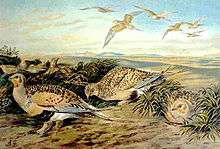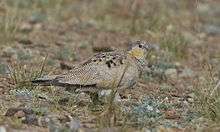Syrrhaptes
Syrrhaptes is a genus of birds in the sandgrouse family. The genus name is from Ancient Greek surrhaptos, "sewn together"; the feathered toes of birds in this genus are fused together.[1]
| Syrrhaptes | |
|---|---|
 | |
| Pallas's sandgrouse | |
| Scientific classification | |
| Kingdom: | Animalia |
| Phylum: | Chordata |
| Class: | Aves |
| Order: | Pterocliformes |
| Family: | Pteroclidae |
| Genus: | Syrrhaptes Illiger, 1811 |
| Species | |
|
Syrrhaptes tibetanus | |
There are two central Asian species.
| Image | Scientific name | Common Name | Distribution |
|---|---|---|---|
 | Syrrhaptes tibetanus | Tibetan sandgrouse | mountains ranges of Central Asia, Tibet, Central China and the Himalayas |
.jpg) | Syrrhaptes paradoxus | Pallas's sandgrouse | Kazakhstan, Mongolia, across Europe as far west as Great Britain |
These are large birds breeding in open steppes or plateau. They nest in a ground scrape into which three eggs are laid.
Both species have mainly buff upperparts, an orange face and feathered legs and toes. They are smaller-headed than other sandgrouse, but have sturdy compact bodies.
The small feet lack a hind toe, and the three front toes are fused together. The upper surface is feathered, and the underneath has a fleshy pad. The appearance of the foot is more like a paw than an avian foot.[2]
Although there is range overlap, they are easily distinguished. Tibetan sandgrouse has a white belly and black underwings, whereas Pallas's has a black belly and white underwings.
These birds are gregarious like other sandgrouse. Flocks fly to watering holes at dawn and dusk, on long pointed wings.
References
- Jobling, James A (2010). The Helm Dictionary of Scientific Bird Names. London: Christopher Helm. p. 376. ISBN 978-1-4081-2501-4.
- van Grouw, Katrina (2012). Unfeathered Bird. Princeton University Press. pp. 242–243. ISBN 978-0691151342.